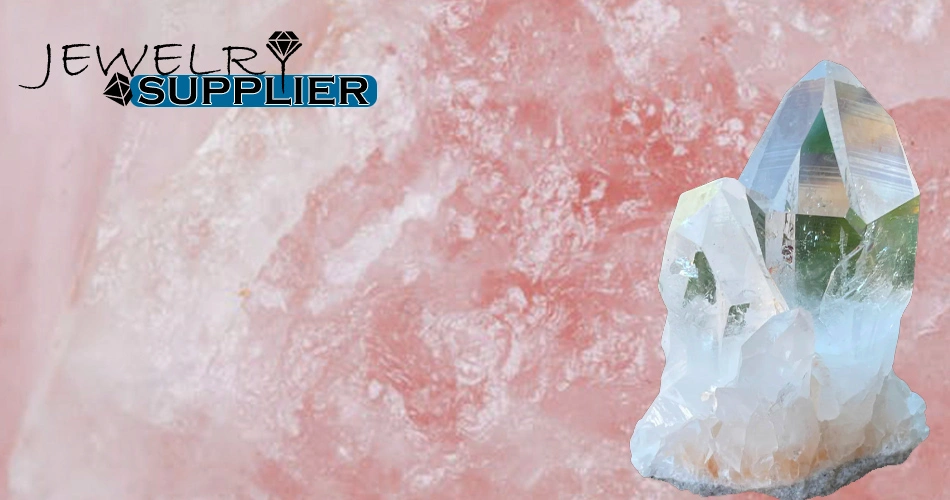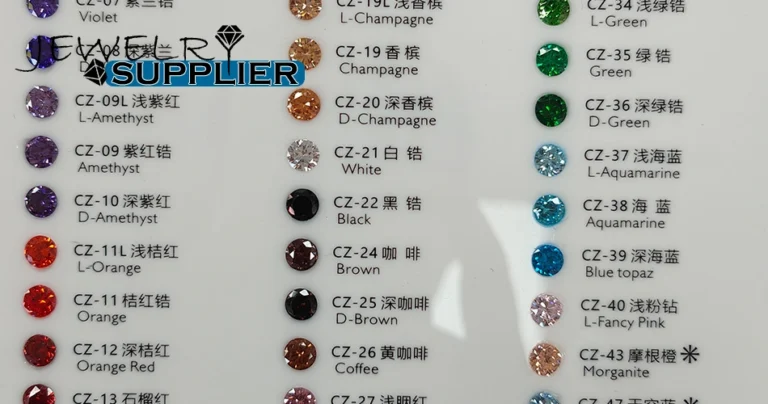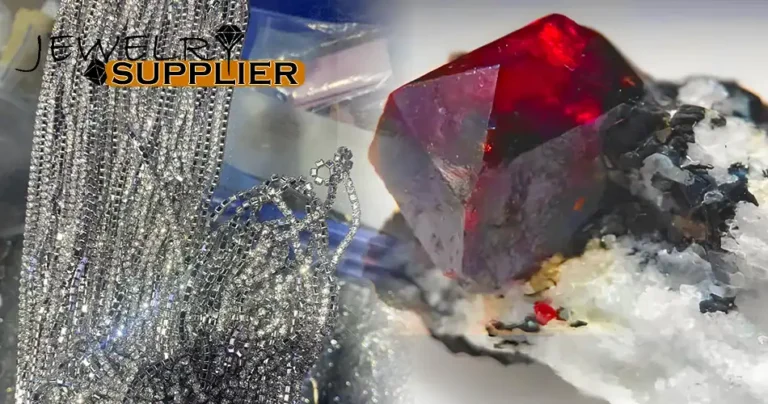Quartz: A Gemstone with Versatility and Style
Quartz is a hard, crystalline mineral composed of silicon dioxide (SiO₂). In gemology, pure quartz crystals are often referred to as “rock crystal.” There are two primary forms of quartz—the standard α-quartz and the high-temperature β-quartz, both of which are known for their chirality (having a distinct “handedness” in their structure). The crystals typically form in hexagonal prisms and can appear as clusters, granular masses, or massive formations.
Quartz comes in a rainbow of colors, thanks to trace impurities that introduce distinct hues, making it a highly sought-after material in custom jewelry design. Beyond its aesthetic appeal, the diverse forms and colors of quartz give it a unique versatility, making it applicable not just in the jewelry industry but also in sectors like construction and glass manufacturing. From intricate gemstone designs to durable building materials, quartz truly proves itself as a material that’s as functional as it is fashionable.
Quartz Crystal Habit and Structure
Quartz is one of the most abundant minerals in the Earth’s crust and comes in two primary forms: α-quartz and high-temperature β-quartz, both exhibiting a fascinating chirality (handedness). Typically, quartz exists in its low-temperature α-quartz form within the trigonal crystal system. It often appears as hexagonal prisms and is known for its twinning phenomenon. Quartz can be found in clusters, granular textures, or massive aggregates, offering a wide variety of natural formations.
The color spectrum of quartz ranges from colorless and transparent to shades of violet, rose, and smoky hues. These vibrant colors result from trace impurity elements within the crystal, adding to quartz’s versatility and aesthetic appeal in various applications. Structurally, every silicon atom in quartz is connected to four oxygen atoms through strong covalent bonds, forming the signature silicon-oxygen tetrahedra. These tetrahedra interlink in a spatial pattern to create the robust framework structure that defines quartz’s durability.
With a hardness of 7 on the Mohs scale, conchoidal fracture, and a lustrous sheen reminiscent of glassy brilliance, quartz is as tough as it is stylish. Its density of about 2.65 g/cm³ and remarkable chemical stability make it resistant to all acids except hydrofluoric acid. This unique combination of strength, beauty, and stability makes quartz a true standout in the world of minerals. For more in-depth insights on quartz, refer to Wikipedia.
The Major Varieties of Quartz
As a common mineral, quartz boasts a diverse range of varieties, each with its own unique properties and industrial applications. Let’s break down some of the key types of quartz and what makes them special.
Data sheet of commonly used raw materials for jewelry
1. Vein Quartz
Vein quartz forms from magmatic or metamorphic hydrothermal fluids filling fractures in rock. It typically has a high SiO₂ content with low levels of impurities, making it an ideal source material for producing high-end glass, silica powder, industrial silicon, and ultra-pure quartz products. Its mineral composition is simple, and it is highly workable, giving it a premium status in value-added industries.
2. Quartzite
Quartzite originates from the metamorphic recrystallization of quartz sandstone or other siliceous rocks. With a typical SiO₂ content of over 85%, quartzite is known for its high-purity raw material, large-scale deposits, and ease of extraction. It’s widely used across industries such as glassmaking, metallurgy, petroleum fracturing, chemicals, and machinery casting, thanks to its robust structural properties.
3. Quartz Sandstone
Quartz sandstone is a sedimentary rock formed through weathering, erosion, transportation, deposition, and subsequent cementation of source rocks. With an SiO₂ content usually exceeding 90%, it is a staple material in ceramics, metallurgy, refractory materials, and large-scale production sectors.
4. Natural Quartz Sand
Natural quartz sand is derived from marine or fluvial transportation and consists of unconsolidated quartz grains. With an SiO₂ content above 90%, it may contain minor amounts of feldspar and mica. Its easy extraction, medium grain size, and favorable angularity make it ideal for metallurgy, ceramics, foundry sand, and petroleum fracturing.
5. Powder Quartz
Powder quartz forms from the weathering and residual accumulation of siliceous limestone or other silicon-rich rocks. With high SiO₂ purity, excellent crushability, and stable quality, powder quartz is used extensively in wear-resistant materials, silica powder production, refractories, ceramics, and panel industries.
6. Crystal Quartz
Crystal quartz is a pure form of quartz with a crystalline structure, often colored by trace ions. Varieties like amethyst (purple quartz) and citrine (yellow quartz) are highly prized. Due to its small-scale deposits, challenging extraction, and unstable mineral composition, crystal quartz is mainly utilized in piezoelectric devices, optics, and natural gemstones for decorative purposes.
7. Granite Pegmatite
Granite pegmatite is formed from late-stage, volatile-rich granitic magma. It serves as a critical source for producing ultra-pure quartz and is currently the most important high-purity quartz ore type worldwide.
From jewelry and high-tech applications to industrial materials, quartz stands out as a versatile, multi-faceted mineral, capable of meeting diverse needs with style and sophistication.
Applications of Major Quartz Elements
1. Glass Manufacturing
Quartz is one of the main raw materials for glass production, especially for the manufacture of special glass that requires high temperature resistance and high transparency. Quartz glass is highly regarded for its low thermal expansion coefficient, high chemical stability and excellent optical properties, making it an ideal choice for high-performance glass applications.
2. Electronics Industry
High-purity Quartz is indispensable in the semiconductor industry and is a key raw material for silicon wafer production. The purity of quartz directly affects the performance and reliability of electronic components, making it the cornerstone of cutting-edge microchip technology.
3. Chemical Industry
Quartz materials are favored by the chemical industry for their excellent thermal stability and corrosion resistance. They are often used as reactor vessels or piping materials, especially in environments that require high temperatures and are exposed to strong acids or alkalis.
4. Aerospace
Quartz fibers are highly praised for their light weight, high strength and ability to withstand extreme temperatures, and are an integral part of aerospace component manufacturing. They are frequently used in the construction of spacecraft structural materials and thermal protection systems, demonstrating the versatility and resilience of quartz in advanced engineering.
5. Construction Industry
In the construction sector, quartz sand is used as an aggregate in concrete and mortar, improving the durability and load-bearing capacity of building structures. Its stability and strength contribute to lasting infrastructure and architectural design.
Auxiliary and Decorative Applications
1. Jewelry and Gemstones
Quartz crystals, especially in crystalline forms such as rock crystal, are prized in jewelry Suppliers design for their sparkling clarity and vibrant colors. As a design element, quartz adds a touch of elegance and sophistication, making it a timeless choice for fashion accessories.
2. Interior Decoration
Quartz materials, such as quartz countertops, are popular in interior design for their scratch resistance, heat resistance, and durability. They are often used in kitchen and bathroom surfaces for both functionality and aesthetic appeal.
3. Landscape Architecture
Quartz sand can also be used in landscape architecture as decorative ground cover or water feature fill. Its natural sheen and bright appearance make it a stylish addition to outdoor spaces.
4. Wall Finishes
Quartz coatings or Quartz panels can be used for wall finishes, providing a surface that is not only visually appealing but also easy to maintain and clean. This makes Quartz an ideal choice for residential and commercial spaces.
5. Arts and Crafts
Quartz crystals’ unique shapes and colors make them a top choice for creating decorative items and collectibles. Items such as Quartz spheres, carvings, and sculptures showcase the mineral’s natural beauty and are sought after by collectors and art enthusiasts.







